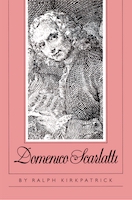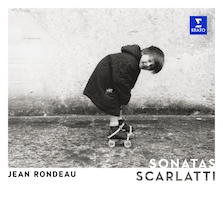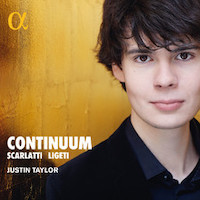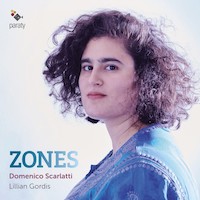Pièces de Clavecin 13. / Scarlatti para siempre 1.
|
Grant Chu Covell [October 2021.] Domenico Scarlatti (1685–1757) has been a large part of my routine this year. I am sure I’ve heard each keyboard sonata at least once, and, considering performers’ favorites and their programs, there are many I have heard frequently. Being a completist, I unfailingly return to Scott Ross and Carlo Grante’s traversals. I have also dipped into different performance practices (Tausig, Friedman, Granados, et al.) and earlier performers (Landowska, Kirkpatrick, Horowitz, et al.). The 555+ extant sonatas depict a fluid universe not unlike Mahler’s symphonies or Schubert’s songs, though the scope is decidedly narrower. Familiarity with Feldman’s epics can help penetrate what appear to be so many repetitions of the same gestures in the same formal structure. However, like any cosmos, there are astonishing and delightful details. Where else can you find so many three-bar phrases and music that may instantaneously change mood and key? We could imagine the span of Scarlatti’s sonatas as a twilight diary. Here is a composer who perhaps because of the imposing legacy of his father, Alessandro Scarlatti (1660-1725), decamped from Italy and its operatic tradition, sidled up to the Portuguese and Spanish courts, and late in life wrote hundreds of articulate character pieces. Trained in Italy, Scarlatti’s sonatas are nonetheless infused with Iberian dance gestures and guitar effects. It is believed he wrote the sonatas for his patron, Princess Maria Barbara who eventually became Queen of Spain.
Ralph Kirkpatrick’s Domenico Scarlatti (Princeton University Press, 1953; rev. 1983, ISBN 9780691027081) has helped build an impression of the entirety of Scarlatti’s life and work. However, there are gaps in the composer’s biography, and there are no extant autographs of the sonatas. The first 30 sonatas, the 30 Essercizi were published in 1738/39. Subsequent bound and copied volumes were prepared in the 1750s. Scarlatti would have been in his fifties when the 30 Essercizi appeared, and in the 1750s, as the Parma and Venice editions were produced (so named because that is where these volumes currently reside), he would have been in his mid-60s. It is believed he wrote all the sonatas late in life. These are the works of a composer who knew what to say and how to say it, and who was probably fine with writing for himself or for his Queen. Here’s a two-part rundown of some recent Scarlatti sonata recordings on harpsichord and piano. For numbering, Kirkpatrick’s catalog has become the standard. The K. numbers are roughly chronological despite some educated guessing in the 31 to 147 range.
Domenico SCARLATTI: Var. Sonatas. K. 208, 175, 69, 141, 213, 216, 162, 132, 6, 180, 30, 119, 199, 460, 481 (ca. 1738-57). Jean RONDEAU: Interlude (2018). Jean Rondeau (hpsi). Warner Classics / Erato 0190295633684 (1 CD) (www.warnerclassics.com). “Continuum.” Domenico SCARLATTI: Var. Sonatas. K. 141, 32, 115, 18, 208, 175, 492, 27, 213, 239, 519, 481 (ca. 1738-57). György LIGETI: Passacaglia Ungherese (1978); Hungarian Rock (Chaconne) (1978); Continuum (1968). Justin Taylor (hpsi). Alpha 399 (1 CD) (www.outhere-music.com). Rondeau and Taylor execute five sonatas in common (K. 141, 175, 208, 213 and 481). Programming accepted favorites can help listeners find their way. Rondeau and Taylor offer distinctive program choices: Rondeau inserts an improvised intermission and Taylor includes Ligeti’s three harpsichord pieces. Overall, Rondeau is a relaxed Scarlatti performer. The slow sonatas (K. 208 and 213) can be deliberate indeed. However, Rondeau goes the extra mile where Scarlatti suggests the quixotic and whimsical as in K. 216, and the sudden mood changes of K. 162. Rondeau’s 30-second interlude (after the eighth of a set of 15) passes in a flash. If Rondeau is elegant, Taylor is more vigorous. Both are stylish players, but Taylor adds playful flair on repeats and provides incisive attacks. K. 141’s first idea leverages repeated notes unmistakably inspired by guitar playing. Taylor’s friskiness verges on violence whereas Rondeau seems determined to ensure distinct sixteenth notes. Taylor’s tempos can be slightly faster (Taylor’s K. 141 is 3:48, Rondeau’s is 4:11), however Taylor’s K. 213 is 9:14 compared to Rondeau’s 5:52. Among Taylor’s choices is K. 32, the well-known Aria, easily essayed by beginners, but whose simple melody can be elusive. Taylor flourishes in the showy sonatas, K. 175, 27 and 239, digging into the percussive dissonance of K. 175, enjoying the flash of the rocking octave motif. Both Rondeau and Taylor conclude with the somber K. 481. Ligeti is a logical pairing for Scarlatti; both composers are detailed craftsmen. It is possible to hear Passacaglia Ungherese as an instance of binary form, as the repeating progression is ornamented. Hungarian Rock’s jazziness echoes the dance rhythms of the preceding K. 175. Continuum never fails to surprise with its frantic repeated notes and lack of themes. Decades later, it sounds like nothing else, an electronic blur. Updated instances of Scarlatti’s intricate figurations appear in Ligeti’s piano music, Musica ricercata and the Études. K. 180, which Rondeau plays but Taylor does not, contains a passage that prefigures Ligeti: At the beginning of the B section, Scarlatti’s harmonies drift and he builds chords in a wedge shape, adding closely spaced dissonant notes until arriving at the desired key. I enjoy Taylor’s Scarlatti / Ligeti program but find Rondeau more perceptive.
“Zones.” Domenico SCARLATTI: Var. Sonatas. K. 119, 87, 25, 122, 215, 262, 402, 264, 516, 253, 474, 248, 208 (ca. 1738-57). Lillian Gordis (hpsi). Paraty 919180 (1 CD) (www.paraty.fr). In effusive notes, Gordis explains that each sonata creates its own “zone,” meaning both physical domain as well as mindset, and that within a sonata, phrases may break off unexpectedly, that there are unexpected, even illogical turns and events, but because Scarlatti was a master of his art, everything makes sense at the end. She would like us to hear her program as three groups of four (the frequently programmed K. 208 arrives as the lucky thirteenth). In K. 119, Scarlatti builds a cadence by accruing tonic and dominant pitches so we eventually hear clusters (G, Bb, D, G and A in the left hand, and G, A, Bb, D, E, G in the right) which Gordis delights in hammering out. The same effect also occurs at the start of the B section in K. 215, however, the weighty Andante hides the dissonance of the superimposed chords (C#, F#, G# and C# in the left hand, and C#, E#, F#, G# and B in the right). Scarlatti often superimposes dominant and tonic eschewing traditional cadential formulas. K. 87, one of Scarlatti’s particularly expressive sonatas, suggesting late Couperin, is finely drawn. (It is thought Scarlatti did not know Couperin’s music.) Considering Gordis’ groups of four, the last quartet, K. 516, 253, 474, 248 offers less-familiar sonatas in a slow-fast-slow-fast arrangement. K. 516 is grand and stately, K. 253 slightly more frivolous but both offer Scarlatti’s characteristic blend of Italian and Spanish. K. 474 contains an obsessive mid-range gesture, neither cadential figure nor accompaniment. K. 248 fleetingly suggests military maneuvers, but also offers inexplicable closing gestures and unexpected transitions. (Onwards to part two.)
[More Grant Chu Covell, Pieces de Clavecin]
[Previous Article:
Used Bin Troll Tweets AAA.]
[Next Article:
Piano Factory 29. / Scarlatti para siempre 2.]
|



